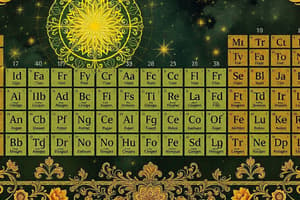Podcast
Questions and Answers
What did Dmitri Mendeleev devise back in the mid nineteenth century?
What did Dmitri Mendeleev devise back in the mid nineteenth century?
- The atomic theory
- The periodic table (correct)
- The electron configuration model
- The molecular bonding principle
What does the atomic number of an element represent?
What does the atomic number of an element represent?
- Number of neutrons in the atom
- Total number of protons and neutrons in the atom
- Number of electrons in the atom
- Number of protons in the atom (correct)
What determines how an element reacts?
What determines how an element reacts?
- Number of protons in the nucleus
- Number of electrons in the outermost shell (correct)
- Atomic mass of the element
- Number of neutrons in the atom
What do elements in the same group of the periodic table have in common?
What do elements in the same group of the periodic table have in common?
What is the general trend of reactivity for Group 1 elements?
What is the general trend of reactivity for Group 1 elements?
Which group of elements are known as the noble gases?
Which group of elements are known as the noble gases?
What separates the metals from the nonmetals on the periodic table?
What separates the metals from the nonmetals on the periodic table?
What are the elements in the middle of the periodic table known as?
What are the elements in the middle of the periodic table known as?
What does the group number of an element tell you?
What does the group number of an element tell you?
What is the far-right group on the periodic table called?
What is the far-right group on the periodic table called?
What does the mass number of an element tell you?
What does the mass number of an element tell you?
What do the elements in each vertical column of the periodic table have in common?
What do the elements in each vertical column of the periodic table have in common?
Flashcards are hidden until you start studying
Study Notes
Dmitri Mendeleev and the Periodic Table
- Dmitri Mendeleev devised the periodic table in the mid-nineteenth century, organizing elements based on atomic mass and properties.
Atomic Number
- The atomic number of an element represents the number of protons in its nucleus, defining the element's identity.
Element Reactivity
- An element's reactivity is determined by its electron configuration, particularly the valence electrons.
Groups in the Periodic Table
- Elements in the same group of the periodic table share similar chemical properties and have the same number of valence electrons.
Reactivity of Group 1 Elements
- The general trend of reactivity for Group 1 elements (alkali metals) increases down the group, with elements becoming more reactive as atomic size increases.
Noble Gases
- Noble gases are found in Group 18 of the periodic table and are known for their lack of reactivity due to a complete valence shell.
Separation of Metals and Nonmetals
- A zigzag line on the periodic table separates metals from nonmetals, with metals located on the left and nonmetals on the right.
Transition Metals
- The elements in the middle of the periodic table are known as transition metals, characterized by their ability to form various oxidation states.
Group Number Significance
- The group number of an element indicates the number of valence electrons, which influences the element's chemical behavior.
Far-right Group of the Periodic Table
- The far-right group on the periodic table is known as the noble gases, recognized for their stability and low reactivity.
Mass Number
- The mass number of an element tells you the total number of protons and neutrons in the nucleus, providing insight into the isotopes of the element.
Vertical Column Commonality
- Elements in each vertical column (or group) of the periodic table have similar properties and reactivity patterns, attributable to their equivalent electron configurations.
Studying That Suits You
Use AI to generate personalized quizzes and flashcards to suit your learning preferences.




